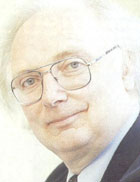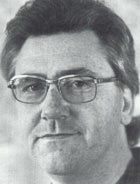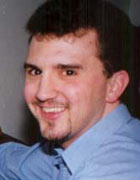2008 European Brass Band Championships - Own Choice selections
28-Apr-20084BR has a look at the selections made by the bands to showcase their abilities and try and win valuable points to become European Champions.
 Music of the Spheres - Philip Sparke
Music of the Spheres - Philip Sparke
(To be played by two bands)
Music of the Spheres was written late 2003/early 2004 and reflects the composer's fascination with the origins of the universe and deep space in general.
The title comes from a theory, formulated by Pythagoras, that the cosmos was ruled by the same laws he had discovered that govern the ratios of note frequencies of the musical scale. (‘Harmonia' in Ancient Greek, which means scale or tuning rather than harmony – Greek music was monophonic).
He also believed that these ratios corresponded to the distances of the six known planets from the sun and that the planets each produced a musical note which combined to weave a continuous heavenly melody (which, unfortunately, we humans cannot hear). In this work, these six notes form the basis of the sections MUSIC OF THE SPHERES and HARMONIA.
The pieces opens with a horn solo called t = 0, a name given by some scientists to the moment of the Big Bang when time and space were created, and this is followed by a depiction of the BIG BANG itself, as the entire universe bursts out from a single point.
A slower section follows called THE LONELY PLANET which is a meditation on the incredible and unlikely set of circumstances, which led to the creation of the Earth as a planet that can support life, and the constant search for other civilisations elsewhere in the universe.
ASTEROIDS AND SHOOTING STARS depicts both the benign and dangerous objects that are flying through space and which constantly threaten our planet, and the piece ends with THE UNKNOWN, leaving in question whether our continually expanding exploration of the universe will eventually lead to enlightenment or destruction.
Philip Sparke
 Vienna Nights – Philip Wilby
Vienna Nights – Philip Wilby
(To be played by two bands)
Philip Wilby's masterful fantasy on Mozart's Piano Sonata in A, K331 is arguably his finest work for brass band and will become an instant classic of the genre.
No other composer for brass could so successfully bring together two such diverse strands of compositional matter and architecture into one coherent symbiotic relationship like he has done here.
It is a breathtaking achievement of subtle mastery for Wilby has achieved the musical equivalent of turning base metal into pure gold. This is brass band compositional alchemy, and the result is quite startling.
The key is perhaps found in the subtitle to ‘Vienna Nights' itself. Wilby calls it a ‘fantasy' which allows him the scope to develop his own thoughts and themes, structures and ideas without ever losing the purity of the original thematic material.
It is not an arrangement, realization, transcription of straight copy and paste job of the original with added on bits. If it were, it would have been a disaster. What we get therefore is a classically structured piece in Sonata form where the germ of the original musical thought is developed without ever changing its historical DNA.
The Mozart music that forms the basis of the work is untouched and allowed to stand alone in all its glory, however brilliantly Wilby surrounds it with his kaleidoscopic array of inspired personal ideas.
It is therefore a piece that delineates the dichotomies between the two composers to the full – the almost simplistic beauty of Sonata and the joie-de-vivre of the Turkish Rondo allied to the intervening more muscular and complex layers of Wilby and his own homage to the 12 tone harmonics of Schoenberg. The result as we have said – is quite something indeed.
The piece, played in one continuous movement is broken into the sonata form: The first entitled ‘Freud's Dreams' is itself homage to the great thinker and father of psychoanalysis. This short introductory section leads to part 2 – ‘Variations' which itself is broken into a series of continuous variations on the Mozart theme from the Piano Sonata.
The nine mini variations cover just about every aspect of musical development you can think of, but always at their core is a pure circulatory bloodline, like a series of veins and arteries connecting every musical strand to the Mozart heart. The third section is marked ‘Scena and Notturno' and is the most operatic in style and content before that itself sets the scene for the finale.
This is the romp of the ‘Finale Alla Turca' brought to life with an injection of pace that would leave the sprinter Marion Jones in her tracks. This is still very much Mozart, but Mozart on a diet of Red Bull chasers – it's wickedly joyful, devilishly difficult and quite amazing to listen too (and we suspect to play).
Iwan Fox
 Concerto Grosso: Opus 61A – Derek Bourgeois
Concerto Grosso: Opus 61A – Derek Bourgeois
'Concerto Grosso' was written by the composer as far back as 1979, and was originally not a full brass band composition. The initial piece was in fact written for the Philip Jones Brass Ensemble, a ten-piece made up of four trumpets, 1 French horn, 4 trombones and a tuba and was written especially for Philip Jones' farewell concert.
Bourgeois was at that time the Professional Musical Director of the Sun Life Band in Bristol and when in 1982 the band was asked to perform on the BBC radio programme "Bandstand" the composer took the opportunity of re-scoring the work for full band.
Although an immense "tour de force" the composer believes it to be within the capabilities of most top class Championship bands, although he believes that organisers of the major contests have been reticent to use the piece due to its length – it is 20 minutes long.
The term ‘Concerto Grosso’ is used by the composer in the baroque sense as throughout the work much is made of smaller ensembles featured against a larger accompanying background.
Written in three main parts it is played as a continuous piece and explores in each of its sections material that ranges from the technically brilliant to the sombre, beautiful melodic yet with a real sense of fun and wit.
Each of the major solo players within a band has material that extends their capabilities to the limit whilst the ensemble is tested to the full. Influences of jazz, blues an even a Charles Ives inspired rumba are heard throughout although the initial motto theme announced at the outset returns time and time again throughout the piece.
It remains today perhaps the most vividly brilliant of brass band compositions.
Iwan Fox
 Music for Battle Creek – Philip Sparke
Music for Battle Creek – Philip Sparke
(To be played by three bands)
Now this is a difficult test piece.
If they were to give out medals as they used to do for winning the Nationals all those years ago then the players of all the bands that have to perform ‘Music for Battle Creek’ this weekend should deserve to wear more gongs on their band tunics than Herman Goering used to show off.
Solo cornet and principal euphonium players in particular could well be in line for Congressional Medals of Honour if they can escape unscathed from this particular ‘Battle’, whilst trombonists, horn, baritone, and soprano players could well end up with a Purple Heart or two – some possible posthumously. There could be more musical victims on this one than a particularly gruesome episode of American television programme CSI.
The man responsible is of course a Brit - Philip Sparke, who has done it again with a wonderfully exciting and colourful test piece, which just happens to have more pyrotechnical hoops in it than a Chinese fireworks circus act – Americana style.
Written for the Michigan based professional Brass Band of Battle Creek - hence the title (although the publishers have been a touch disingenuous in the study score notes by using the past tense to describe the date of a future premiere performance - what happens if someone else decides to play the piece before Xmas this year? ) it is certainly a showcase work for a band that contains a whole platoon full of star performers on any instrument you may care to mention.
As a result it is geared towards their particular brand of professional expertise, technical virtuosity and intuitive appreciation of musical style. It’s everything you could imagine you would like to hear world class American performers play in 15 minutes of music – all wrapped up in a musical Star Spangled Banner.
Excitement, bravado and virtuosity was the stated aim of Philip Sparke with the piece, and excitement, bravado and virtuosity is what you get by the bucketful.
It should not therefore come as a surprise that it is heavily scored, with just about something for everyone to do in just about every bar of the piece. Why waste an opportunity to allow brilliant players the chance to show off – anyone old Tom, Dick or Bubba can count bars rest.
The three main sections of the work (there is a small connecting Interlude between the first and second sections) are played continuously, but are easily identifiable.
The opening fanfares give way very quickly to the first major hurdle – a stunningly difficult unison duet cadenza between the solo cornet and euphonium which stretches technique and nerve like a piece of Wrigley’s gum. You will be able to identify any principal cornet or euphonium at the hall on the day by their deathly pallor, for all of them would have had sleepless nights about the bars 13 – 28, with bar 24 in particular an absolute nightmare.
Get over this and things get a little easier – but what a start: nail it and glory may beckon; get out of synch or clip a few and you could possibly say goodbye to having any hope of making an impression early doors.
All through the band ensemble is required to perform at a very high level with detailed filling and precision motifs allied to very specific dynamics. It’s a corkscrewing roller coaster at times, but a roller coaster that could just leave the track with horrendous consequences if a band opts for too much speed and very little subtlety – the depth of the scoring at times is bewildering.
Amid it all though class will surely out, with the opportunity for the very best players on the day to make significant impressions even in the tiniest of places. Keep an ear cocked for any soprano player who can ping out top E’s at one point and percussion teams who can add colour and clarity – those who just whack it thinking they are adding to the excitement will surely be taken out with a well placed snipers bullet of a handful of lost marks from the judges box.
The short interlude finishes off the opening third of the piece and by then you should be able to recognize whether you are hearing a band that can play the test piece and are capable of showcasing their talents to the full, or those who think they can and are using more camouflage make up than Joan Collins in an old Dynasty episode.
The Elegy that follows allows the best bands to also reveal their ability to perform at the other extreme – this time in dynamics and controlled musicality. Small declamatory solo episodes will certainly test the baritone, trombone, flugel and horn, but once again it will be the solo cornet and euphonium that will bear the brunt of front line battle.
The key elements will surely be the expressive Tranquillo (which again asks so much of the main soloists in unison) and the ethereal Luminoso, which of course means bright, but bright in an almost unworldly way – magical if it comes off.
Marked ppp, despite the complexity of the scoring it is a quite sublime moment of brass writing. Soprano players who cannot play very, very quietly without the aid of a mute will hold the key. How many will take the safety option we wonder and chicken out?
The following Estatico will also take some playing too – almost Wagnerian in its glory (and again so intricate in construction) before a final moment of tranquil repose before the finale.
Now comes the tricky bit. The Rondo Finale is marked minim = 120, but that may be a touch elastic in the hands of the best bands. The best bands will also be the only ones to capture the style of the jazz inspired writing.
Brass Band of Battle Creek has plenty of players who can do this stuff brilliantly in their sleep of course, but British bands don’t and it could result in some efforts sounding pretty dire – perhaps technically secure but musically as stiff as a half eaten buger bap from McDonalds. This should jink and twitch as if run on an electric current – although crucially it should be as one with precise detail in the various ensembles that take the leading lines. If not, it will just sound a complete Horlicks of a mess (or the American equivalent if there is such a thing) – the devil on this one is in the detail.
It all hits top dollar of course in true Sparke style – thrillingly so with even a hint of Purcell(?) making a fleeting appearance (just perhaps to subtly inform the Americans that our British musical heritage didn’t quite start with Sousa or Jelly Roll Morton). The ending though may come as a bit of a surprise to start with – a last test of composure for the solo cornet and Eb tuba before a final bar that ends as abruptly as a crack from a cowboy’s whip.
Very, very, difficult indeed – but a piece that should keep the punters happy even if the players will know that they have been in a ‘Battle’ to remember. The medal giving ceremonies could well resemble the final roll call at Rourke's Drift.
Iwan Fox
 The Year of the Dragon – Philip Sparke
The Year of the Dragon – Philip Sparke
The highlight of Cory’s centenary celebrations throughout 1984 was a concert held in St. David’s Hall, Cardiff, in March. The band, with the aid of funds provided by the Welsh Arts Council, commissioned Philip Sparke to write a work for first performance at this concert.
The result was “The Year of the Dragon” of which the composer writes:
“At the time I wrote The Year of the Dragon, Cory had won two successive National Finals and I set out to write a virtuoso piece to display the talents of this remarkable band to the full.” The work is in three movements:
TOCCATA opens with an arresting side drum figure and snatches of themes from various sections of the band, which try to develop until a broad and powerful theme from the middle of the band asserts itself. A central dance-like section soon gives way to the return of this theme, which subsides until faint echoes of the opening material fade to a close.
INTERLUDE takes the form of a sad and languid solo for trombone. A chorale for the whole band introduces a brief spell of optimism but the trombone solo returns to close the movement quietly.
FINALE is a real tour-de-force for the band with a stream of rapid semi-quavers running throughout the movement. The main theme is heroic and march-like but this is interspersed with lighter, more playful episodes. A distant fanfare to the sound of bells is introduced and this eventually returns to bring the work to a stirring close.
Philip Sparke
 Apocalypse: Opus 187 – Derek Bourgeois
Apocalypse: Opus 187 – Derek Bourgeois
’Apocalypse’ was written at a time when the composer believed he was incapable of following the avant garde path of the likes of Stockhausen, Boulez or Birtwistle, although he wishes to explore the extremities of his own musical aggression and violence.
The title refers to the biblical revelations of St John the Divine in which the end of the world and all its accompanying disasters are foretold.
The piece itself follows no central thematic core, but consists of several sections that are varied in both pace and style. The idioms though are clear for all to hear: destruction, pain, domination, warfare, attack, combat, hostility, offence, strife and struggle, as the composer takes us through the final spasms of the end of civilisation.
The composer himself stated that he wanted these sentiments to be conveyed to the listener not only by the nature of the musical language, but also by the struggle of the players trying to negotiate through the minefield of rhythmic and technical traps with which the piece abounds.
The opening battering theme recurs time and again (much like Concerto Grosso) and it is this that he states holds the entire piece together – a sort of motto theme as he calls it.
The following section is much slower and is written to represent the sleazier side of human nature. With distant jazz inflections and varied internal rhythmic complexities it is linked with simultaneous contradictory rhythmic pulses, which hold tenuously to the main thematic material.
A demonic scherzo follows, which is paced to invoke no lightness or wit, before a cataclysmic series of cadenzas lead to a sadder lugubrious trombone solo and ensemble lead. All this gradually fades to the sol (or should that be soul) pitch of an Eb bell which perhaps announces the death of human kind.
Finally, all the pent up force of evil is unleashed before a surreal moment of calm reminds us of what has been lost is the pursuit of human vanity and greed. All to swiftly we are thrown into the final abyss and everlasting damnation.
Iwan Fox
With thanks to sleeve notes of Derek Bourgeois in the CD ‘Bourgeois in Brass’.
 Dreams – Bertrand Moren
Dreams – Bertrand Moren
This composition represents various dreams that could have an effect on a dreamer’s life. Its very high level of technical and musical difficulty provides a great challenge for the conductor and musicians.
The first movement, ‘Nightmare’, contains some spine-chilling passages as dissonant chords alternate with aggressive percussion. The central movement develops through a huge crescendo after which the theme is taken up again by the low brass section. Meanwhile, the other instruments improvise on diverse rhythmic and melodic blocks.
The finale is less discordant – it’s joyful atmosphere reminds us of the fact that we always wake up from a nightmare in the end and realize that, all things considered, life is not so bad.
The second movement, ‘Daydream’, is a patchwork of solos. All the brass band soloists are called upon alternately to play serene and soft melodic lines. The movement closes with a virtuosic trombone cadenza which leads the music directly to the opening bars of the third and final movement entitled ‘Visions’.
This movement evokes all kinds of visions: Visions of insanity reflected by violent and discordant descending motifs; ecstatic visions which take the music through a progressive crescendo to a percussive climax; pastoral visions depicted in an ethereal section using the cornet and euphonium soloists to develop a bell-like, light melody with supporting percussion and, lastly, visions of joy presented in a sparkling and cheerful finale.
Bertrand Moren















